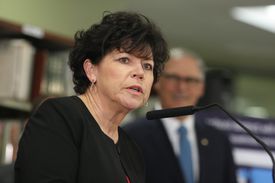Inslee proposes nearly $4 billion increase in K-12 funding, including pay

Tuesday at Lincoln High School in Tacoma, Gov. Jay Inslee released a K-12 budget that includes nearly $4 billion in new state funding for public schools over the next two years, most of it going to substantial increases in educator pay.
Beginning teacher pay in the 2018-19 school year would be $54,587, up from the current allocation of $35,700. In addition, the allocation for those with 16 or more years of experience would increase to $84,883, up from current allocation of $67,228. The state allocation for classified staff average salaries rises from $33,989 in 2016-17 to $52,908 in the 2018-19 school year. Those increases include state-funded professional development.
Read WEA's legislative goals and the Student Bill of Rights.
Inslee’s proposal protects existing collective bargaining rights, including the ability to negotiate additional pay for time, responsibility and incentives. The budget also adds $800 million for counselors and other support staff and for further reducing K-3 class sizes, a big step toward fully funding voter-approved Initiative 1351. This chart shows how much additional money school districts would receive under Inslee's plan.
The 2017 legislative session starts Jan. 9, and Inslee’s budget is the starting point for budget deliberations.
Teacher of the Year and WEA member Nathan Bowling-Gibbs, Superintendent-elect Chris Reykdal and WEA President Kim Mead spoke at Inslee’s news conference in support of his education budget. Here are Mead’s prepared remarks:
I applaud Governor Inslee for his leadership on school funding and for writing a bold budget that goes a long way toward fulfilling the promise the Washington Constitution makes to our children. The Constitution is clear: public education is our paramount duty, and all children deserve amply funded public schools, regardless of ZIP code or family background. Governor Inslee’s budget recognizes that amply funded, high-quality public education is a civil right for all students – and they can’t wait any longer.
All students who walk through the school door deserve small class sizes and professional support services that provide the individual one-on-one attention they need. All students deserve to be taught by caring, committed and qualified teachers and education support professionals.
Governor Inslee understands this requires funding competitive, professional base pay and benefits to attract and keep great K-12 teachers and school employees. Educator pay in Washington lags far behind other states and other professions. As a result, our schools are facing a severe shortage of qualified educators. Governor Inslee’s budget makes a substantial investment in increasing pay for Washington’s public school teachers and education support professionals. As the Supreme Court said, “There is nothing more basic than adequate pay.”
Governor Inslee deserves credit for acknowledging that we cannot fully fund public schools and protect vital social and health services without new revenue. Our kids are worth it. I applaud his leadership to present a comprehensive vision of services we expect and deserve in Washington with the revenue needed to support this vision.
I also thank Governor Inslee for recognizing school districts need the flexibility to use local levy funding to meet local students’ needs and to address unique needs and priorities of their communities.
I urge both the Senate and the House budget writers to follow Governor Inslee’s lead and to pass a state budget that invests in smaller class sizes and additional support professionals in our schools, funds competitive pay for all educators and protects the idea that local school boards, parents and educators are the ones who know best what their students need to be successful.
Summary of Gov. Inslee's Proposed K-12 Budget
- $2.4 billion to bring state funding for K-12 employee compensation to competitive wage levels, including higher beginning educator pay and a shift in salary allocation models to one that is compressed and tied to certification level
- $485 million to implement class sizes of 17 in grades K-3
- $337 million to phase in implement 80 hours of professional development for teachers and ESAs and 40 hours for paraprofessionals by the 2018-19 school year
- $325 million to provide 1 FTE for social and emotional support in each prototypical school to be used to be used for school counselors, nurses, psychologists, social workers, and family engagement coordinators. This is phased in at the highest poverty schools first, with full implementation by 2018-19 school year. This is a step toward implementation of I-1351.
- $50 million increase to the Learning Assistance Program.
- $50 million increase for the BEST beginning educator support team program
- $12.3 million to increase the Maintenance Supplies and Operating Costs (MSOC) for CTE programs
- Phase down to a levy cap of 15 percent. While the percent is lower, the base on which that percentage is calculated is much, much higher. Some districts will see a rollback of levy authority, but ALL districts experience a net gain in resources from the combination of new state dollars and levy authority. (WEA supports allowing voters to approve local school levies to meet local needs beyond basic education.)


